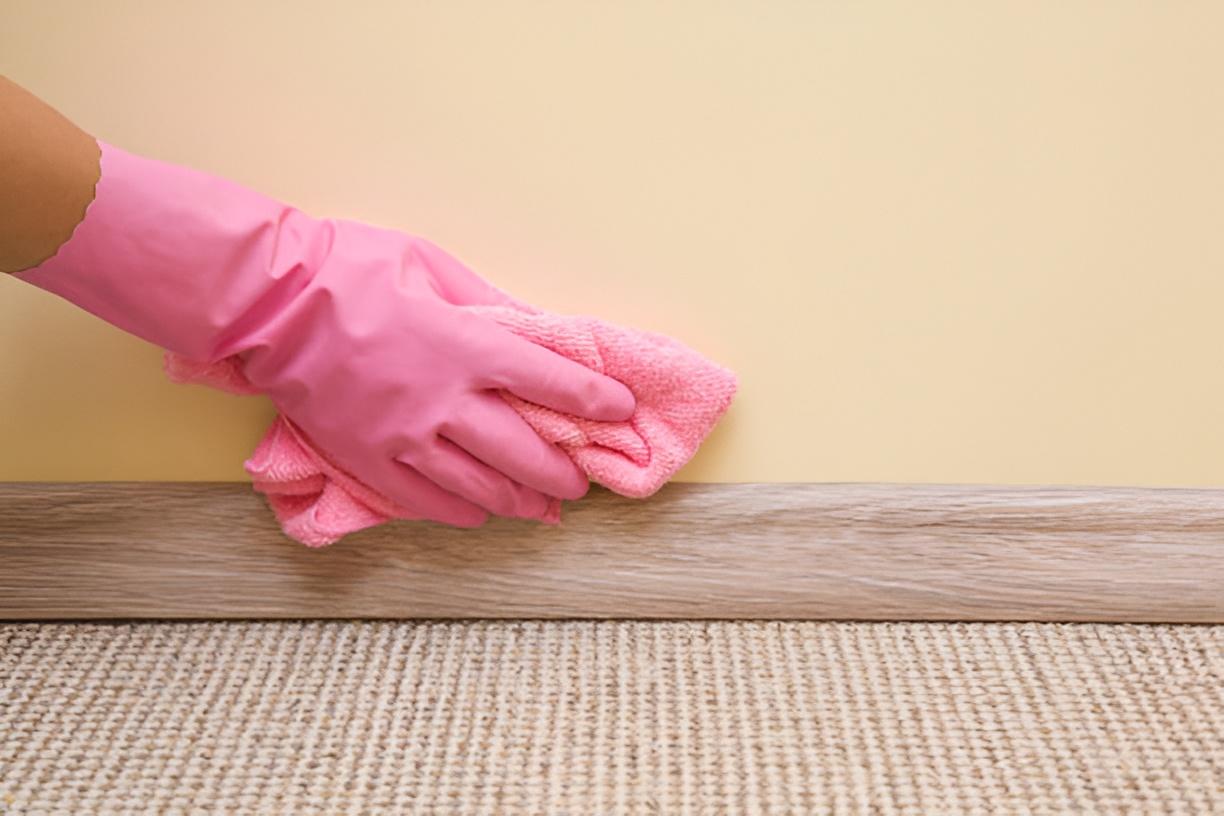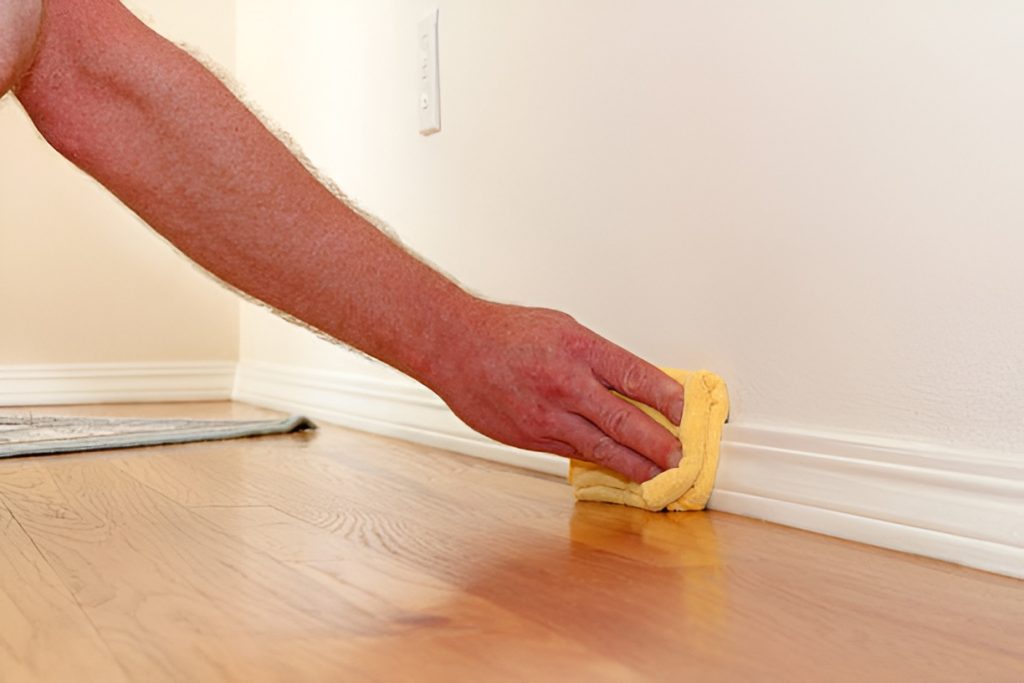- Regular cleaning preserves paint and appearance: Dusting and washing baseboards prevent grime buildup, protect walls from scuffs, and maintain a polished look.
- Start with dust removal: Vacuuming or using a Swiffer duster removes loose dirt and pet hair, making subsequent cleaning easier and safer for paint.
- Use gentle, paint-safe cleaners: Mild soap, all-purpose cleaners, vinegar solutions, or fabric softener mixes can remove grime without damaging painted surfaces.
- Layer techniques for best results: Combining vacuuming, gentle washing, spot cleaning, and dust-repelling finishes ensures thorough and long-lasting cleanliness.
- Deep cleaning options are available: Steam cleaning or degreasers can tackle stubborn stains or heavily soiled areas without harming paint.
- Maintain a routine and avoid common mistakes: Regular light cleaning, working in sections, using microfiber cloths, and avoiding abrasive tools or over-wetting keeps baseboards protected and looking fresh.
Baseboards often get ignored during regular cleaning, but they can make a big difference in how polished your home looks. Dust, dirt, and scuff marks accumulate over time, and cleaning them improperly can damage paint. Fortunately, there are several safe and effective techniques to restore your baseboards without stripping the paint. Here’s a comprehensive guide on how to clean baseboards without removing paint.
Why Cleaning Baseboards Is Important
Clean baseboards do more than look good—they help maintain a healthy and well-kept home. Regular cleaning:
- Removes dust, pet hair, and allergens that accumulate near the floor.
- Improves the overall appearance of your rooms.
- Protects walls from scuffs caused by shoes, furniture, and vacuum cleaners.
- Helps maintain the life of your paint job by preventing grime buildup.
Learning how to clean baseboards and keeping them in good condition reduce the need for frequent repainting or repairs.
What You’ll Need
Before starting, gather these supplies:
- Microfiber cloths or soft rags
- Vacuum with a brush attachment
- Broom, mop, or flat cleaning tool
- Mild dish soap or gentle liquid detergent
- All-purpose cleaner (optional, e.g., Simple Green)
- Liquid degreaser for tough grime
- Fabric softener or dryer sheets for dust repelling
- Vinegar and baking soda for natural cleaning
- Steam cleaner (optional, for deep cleaning)
Having everything ready makes the process easier and safer for your painted baseboards.
1. Vacuuming and Gentle Soap Wash
Start with a simple cleaning approach that works for most homes:
- Attach a brush to your vacuum and remove dust, dirt, and pet hair from the baseboards, including corners and edges.
- Mix a few drops of mild dish soap in warm water.
- Soak a microfiber cloth in the solution, wring it out, and attach it to a broom or mop.
- Wipe along the baseboards, covering the top, front, and corners.
- For stubborn dirt, lightly apply a small amount of liquid degreaser to a cloth and wipe gently.
This method removes most grime without harming the paint.
2. Swiffer Dusters and Dryer Sheets
For quick maintenance and dust prevention:
- Use a Swiffer duster or microfiber cloth to sweep away loose dust, dirt, and pet hair.
- Mix a small amount of liquid detergent with water in a spray bottle. Lightly mist the baseboards and wipe with a clean cloth.
- For a finishing touch, attach dryer sheets to a mop and glide along the trim. This helps pick up leftover dust, leaves a fresh scent, and repels future dust buildup.
This technique is especially useful in high-traffic areas or homes with pets.
3. All-Purpose Cleaner for Stubborn Grime
When grime is tougher to remove:
- Vacuum the baseboards first to remove loose dust.
- Mix warm water with an all-purpose cleaner.
- Apply the cleaner to the baseboards and gently scrub with a sponge, focusing on stained areas.
- Wipe down with a clean cloth to remove any residue.
This is particularly effective for kitchen or entryway baseboards that tend to accumulate grease.
4. Fabric Softener as a Dust Repellent
To help prevent future dust buildup:
- Mix fabric softener with water in a spray bottle and shake well.
- Lightly mist the baseboards and wipe with a microfiber cloth.
- This leaves a smooth, streak-free shine while helping repel dust.
Using a dust-repelling solution makes regular maintenance easier and less frequent.
5. Vinegar Solution for a Natural Clean
For an eco-friendly cleaning option:
- Mix equal parts water and vinegar in a spray bottle.
- Spray lightly on a cloth or directly on the baseboards and wipe gently.
- For tough stains, sprinkle a bit of baking soda on a damp cloth and scrub softly.
This method is safe for painted surfaces and environmentally friendly.
6. Steam Cleaning for Deep Sanitization
For a chemical-free deep clean:
- Use a steam cleaner to loosen dirt, grease, and grime.
- Move the steam head slowly along the baseboards and wipe with a dry microfiber cloth.
- This approach sanitizes and refreshes baseboards without damaging paint.
Steam cleaning works well for heavily soiled or neglected areas.
How Often Should You Clean Baseboards?
Frequency depends on household activity:
- High-traffic areas: Monthly.
- Low-traffic rooms: Every 2–3 months.
- Homes with pets: Monthly, especially where fur collects.
Regular cleaning prevents dirt from embedding and preserves the paint finish.
Common Mistakes to Avoid
Even gentle cleaning can damage baseboards if done incorrectly:
- Using abrasive scrubbers or steel wool.
- Over-soaking baseboards with water.
- Relying solely on harsh chemicals.
- Ignoring corners and grooves where dirt collects.
Avoiding these mistakes helps maintain paint and keeps baseboards looking fresh.
Final Tips: How to Clean Baseboards Without Removing Paint

Test cleaning solutions first
Before applying any new cleaner, whether it’s a commercial product, vinegar solution, or fabric softener mix, try it on a small, inconspicuous section of the baseboard. This ensures that it won’t discolor, streak, or damage the paint. Wait a few minutes to see the results before proceeding with the entire area.
Work in manageable sections
Cleaning baseboards can be tedious, and working too large an area at once can lead to over-wetting and streaks. Divide the room into sections—such as one wall at a time—and focus on one small stretch of baseboard before moving on. This approach keeps the process controlled and reduces the risk of water damage.
Use clean microfiber cloths
Microfiber traps dirt, dust, and hair far more efficiently than regular cloths or paper towels. Always start with a clean cloth, and rinse or replace it as it becomes dirty to avoid spreading grime or scratching the paint.
Combine techniques for thorough results
For the best outcome, layer different cleaning methods. Start with vacuuming or dusting to remove loose dirt, follow with a gentle soap-and-water wash or all-purpose cleaner for stains, and finish with a dust-repelling solution like fabric softener or dryer sheets. This combination cleans deeply while also helping maintain the baseboards for longer.
Maintain a regular cleaning schedule
Frequent light cleaning prevents dirt and grime from building up, which makes deep scrubbing unnecessary. Schedule a routine—monthly in high-traffic areas or around pets, and every few months in low-traffic rooms—to keep your baseboards looking fresh and your paint intact.
Take your time and be gentle
Rushing through the process or scrubbing too hard can damage both the baseboard surface and paint. Gentle, consistent movements combined with the right cleaning solutions are key to preserving the finish while achieving a polished look.
In a Nutshell
Learning how to clean baseboards without removing paint is easier than it seems. By using the right combination of vacuuming, gentle soap washing, all-purpose cleaners, natural solutions, and dust-repelling methods, you can restore and maintain your baseboards safely. Regular attention keeps them looking fresh, prevents dust accumulation, and preserves your paint, making your home cleaner and more inviting.
